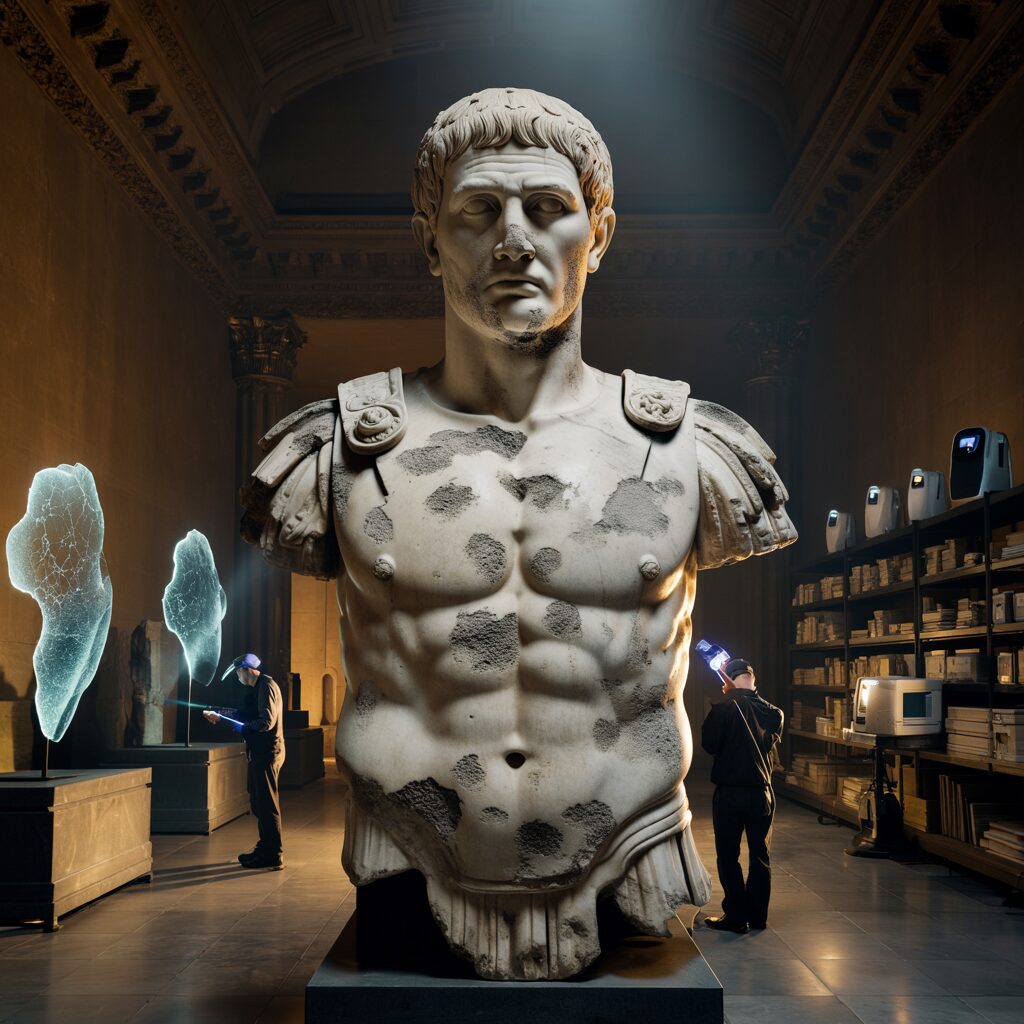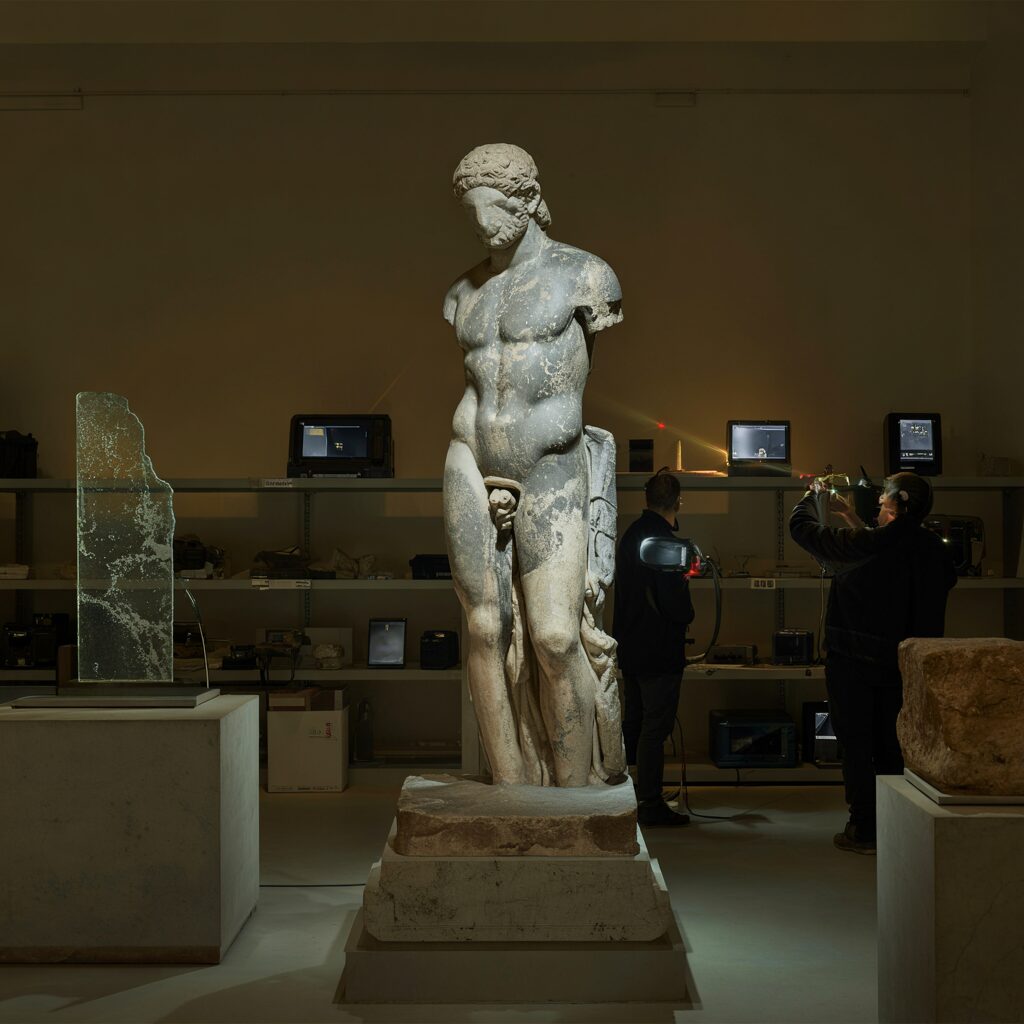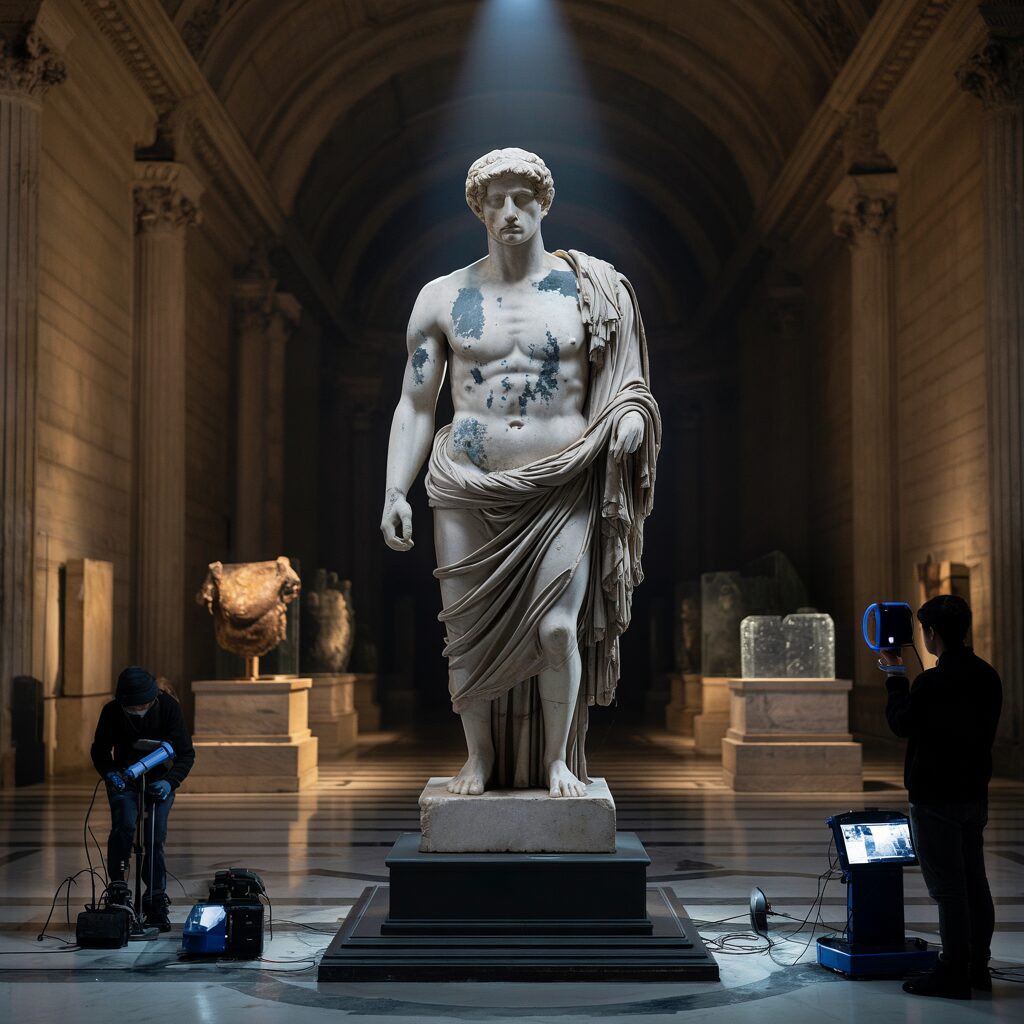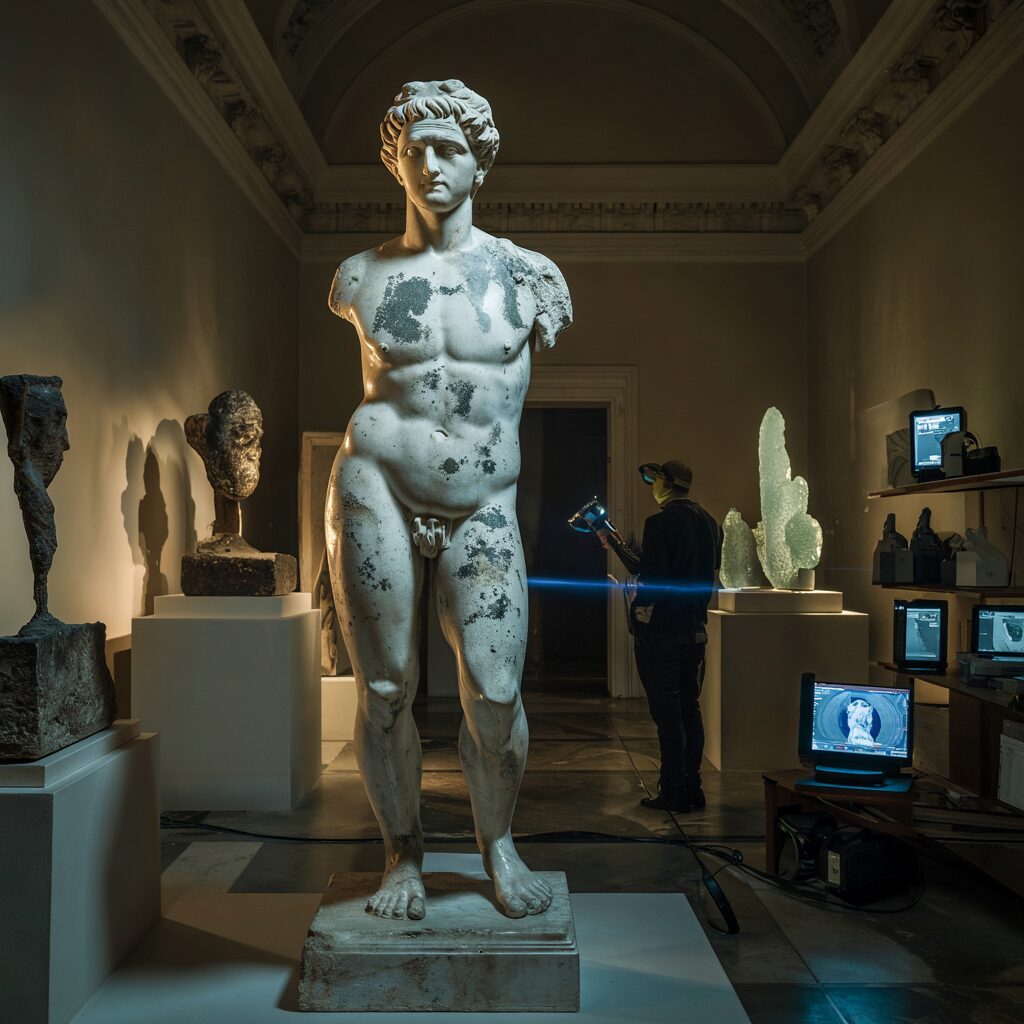The magnificent marble statue stands in the dimly lit museum hall, its surface marred by an irregular pattern of gray and white splotches. What visitors don’t realize is that they’re witnessing the slow death of a masterpiece – not from age, but from the very methods meant to protect it. Across Europe’s museums and archaeological sites, Roman artifacts are silently deteriorating under the watchful eyes of their caretakers, victims of preservation techniques once considered state-of-the-art.
The irony is devastating. The very hands entrusted with protecting our most precious cultural heritage have, in many cases, accelerated its destruction. Traditional preservation methods, some dating back to the Victorian era, are proving catastrophically inadequate for the complex chemistry and material science challenges presented by two-thousand-year-old Roman artifacts. The consequences are irreversible – dissolved pigments, crumbling stone, corroded metals, and cultural context lost forever.
This preservation crisis isn’t merely a technical problem – it represents the potential erasure of our connection to one of history’s most influential civilizations. The stakes couldn’t be higher, yet awareness of this silent emergency remains shockingly low outside specialist circles. However, where conventional methods have failed, innovation is flourishing, offering new hope for our irreplaceable Roman heritage.
The Hidden Damage: How “Preservation” Became Destruction
For centuries, the approach to preserving Roman artifacts followed a deceptively simple philosophy: clean the object, stabilize it, and seal it from environmental factors. This seemingly logical framework masks a troubling reality – these interventions often trigger complex chemical and physical reactions that damage the very artifacts they aim to protect.
Consider the case of marble sculptures, cornerstone pieces in any Roman collection. Traditional cleaning methods employed harsh alkaline soaps that stripped away not just surface grime but also the delicate patina that naturally protected the stone. Even more destructive was the widespread use of acidic solutions to remove stubborn stains, which literally dissolved microscopic layers of the marble surface, erasing fine details and original tool marks forever.
The damage extends beyond aesthetics. These aggressive cleanings have obliterated crucial scientific evidence. Many Roman statues and buildings were originally painted in vibrant colors – a fact only recently understood because traditional cleaning methods stripped away the microscopic pigment particles that would have provided evidence of this polychromy. What we perceive as pristine white marble – the aesthetic that influenced countless neoclassical buildings – is actually a preservation artifact, not historical reality.
Perhaps the most devastating traditional preservation method has been the application of sealants and consolidants. Throughout the 20th century, conservators applied synthetic polymers to “protect” fragile surfaces. Materials like polyvinyl acetate and acrylic resins were painted directly onto porous artifacts, ostensibly to strengthen them. Initially, these treatments appeared successful, but their legacy has become a conservator’s nightmare.
These synthetic coatings inevitably yellow and become brittle with age. Worse, they trap moisture against the artifact’s surface, creating perfect conditions for accelerated deterioration. The tragedy is compounded by the virtual impossibility of removing these treatments without causing additional damage. Many artifacts now bear permanent chemical scars from these well-intentioned but devastating interventions.

The Environmental Blind Spot in Traditional Preservation
Traditional preservation approaches have consistently underestimated the complex relationship between Roman artifacts and their environment. For decades, the prevailing wisdom held that maintaining stable temperature and humidity levels would safeguard artifacts indefinitely. This oversimplification has led to preservation disasters that continue to unfold today.
One of the most misguided practices has been the hermetic sealing of artifacts in climate-controlled display cases with artificially maintained environments. While this approach seems logical on the surface, it fundamentally misunderstands how many Roman materials reached equilibrium with their burial or recovery environments over centuries.
Roman glass provides a telling example of this phenomenon. Traditional preservation methods often involved cleaning glass artifacts with water-based solutions, then sealing them in display cases with controlled humidity. This approach failed to account for the complex chemistry of ancient glass, which develops microscopic cracks through which water molecules can penetrate. The moisture trapped by display case environments accelerates a process called “glass disease” – a destructive cycle where alkaline components leach out, creating a characteristic cloudy appearance and eventually causing structural failure.
The preservation of Roman metals reveals another critical failure of traditional approaches. Bronze and iron artifacts develop stable patinas over centuries of burial that actually protect the metal beneath. Traditional cleaning methods stripped these protective layers, exposing fresh metal surfaces to oxidation. Even more damaging was the practice of applying protective coatings that prevented the artifacts from “breathing” – trapping corrosive agents against the metal surface and accelerating deterioration.
Perhaps the most devastating environmental blind spot has been the failure to recognize the importance of microbial communities in preservation contexts. Many Roman artifacts, particularly those recovered from waterlogged sites, host complex microbial ecosystems that reach a stable equilibrium over time. Traditional preservation disrupted these balances through aggressive cleaning and antimicrobial treatments, triggering rapid deterioration once these artificial interventions inevitably failed.

The Documentation Deficit: When Context Disappears
The physical deterioration of artifacts represents only one dimension of the preservation crisis. Equally devastating has been the loss of contextual information – the crucial data about an artifact’s discovery, surroundings, and associations that give it historical meaning. Traditional preservation approaches often prioritized the physical object over its archaeological context, creating beautiful but historically impoverished museum pieces.
The history of Roman artifact excavation is rife with examples of this phenomenon. Early excavations at sites like Pompeii focused on recovering impressive artifacts for display, often with minimal documentation of their exact location or associated materials. The physical objects were preserved (though often with problematic methods), but their full historical significance was compromised from the moment of discovery.
This documentation deficit extends to conservation treatments themselves. Throughout much of the 20th century, detailed records of preservation interventions were rarely kept, leaving today’s conservators in the dark about what chemicals and methods were previously used on artifacts. This absence of treatment history makes modern preservation efforts exponentially more difficult, as conservators must first identify past interventions before they can address current deterioration.
The traditional emphasis on aesthetic presentation rather than historical integrity has also led to problematic restoration practices. Roman artifacts were routinely “completed” with modern additions to make them more visually appealing to museum visitors. These reconstructions, often done with little archaeological evidence, fundamentally altered the historical record. Even worse, these additions were rarely documented as modern interventions, leading to decades of historical misinterpretation.
Perhaps most troubling is how traditional preservation approaches often isolated artifacts from their cultural contexts. Roman items were typically grouped by material type rather than historical association, severing connections between objects that were used together. This decontextualization fundamentally altered how we understand Roman society, creating artificial categories based on museum convenience rather than historical reality.
The Revolution in Roman Artifact Preservation
Against this backdrop of preservation failures, a quiet revolution has been unfolding in conservation laboratories and archaeological sites across the world. This transformation is built on three foundational shifts: minimally invasive techniques, preventive conservation, and digital documentation. Together, these approaches are redefining what it means to preserve Roman heritage.
The cornerstone of modern preservation is the principle of minimal intervention. Unlike traditional approaches that aggressively cleaned and treated artifacts, contemporary methods prioritize stabilization with the least possible alteration to the original material. This philosophical shift recognizes that every intervention carries risk and that sometimes the best preservation action is simply controlling the environment around an artifact rather than treating the object itself.
Laser cleaning exemplifies this minimally invasive approach. Unlike harsh chemical cleaners or abrasive methods, conservation-grade lasers can remove surface contaminants with remarkable precision, targeting only the unwanted material while leaving the artifact itself untouched. This technology has proven transformative for cleaning stone inscriptions and sculptural details that would be damaged by traditional methods.
Equally revolutionary has been the development of “passive” conservation materials. Traditional preservatives often involved active chemicals that interacted with artifacts in unpredictable ways. Modern alternatives include oxygen scavengers that protect metal artifacts by removing corrosive gases from sealed environments, and specialized silica gels that buffer humidity without direct contact with sensitive materials.
The shift toward preventive conservation represents another paradigm change. Rather than focusing on treating deterioration after it occurs, this approach addresses the environmental factors that cause damage in the first place. Climate-controlled storage with specialized microclimates for different material types has replaced the one-size-fits-all approach of traditional preservation. Even exhibition spaces are being redesigned with conservation in mind, using filtered lighting that minimizes photochemical damage and showcase designs that maintain stable microclimates without hermetically sealing artifacts.

The Digital Preservation Revolution
Perhaps the most transformative development in Roman artifact preservation has been the integration of advanced imaging and analytical technologies. These tools have revolutionized both documentation and treatment approaches, creating unprecedented opportunities to understand and protect cultural heritage.
Multi-spectral imaging has revealed previously invisible aspects of Roman artifacts. By examining objects under different wavelengths of light, conservators can now detect traces of pigment invisible to the naked eye, revealing that seemingly plain marble sculptures were once brightly painted masterpieces. This technology has transformed our understanding of Roman aesthetics and provided crucial guidance for preservation efforts.
X-ray fluorescence (XRF) spectroscopy represents another breakthrough, allowing conservators to identify the exact chemical composition of artifacts without taking samples. This non-invasive technique can determine what metals are present in a Roman coin or what pigments were used in a wall painting, providing crucial information for developing targeted preservation strategies. Even more impressive, portable XRF devices now allow these analyses to be conducted in the field, eliminating the risks associated with transporting fragile artifacts.
Three-dimensional scanning and printing technologies have created new possibilities for both documentation and public engagement. High-resolution 3D scans create permanent digital records of artifacts in their current state, providing crucial baselines for monitoring deterioration over time. These digital models also allow for the creation of precise replicas that can be handled by researchers and visitors without risking the original artifacts.
Perhaps most revolutionary has been the development of predictive modeling for conservation. By combining environmental monitoring with materials science, conservators can now predict how artifacts will respond to different conditions over time. These models help identify artifacts at highest risk and allow for proactive intervention before visible deterioration occurs – a dramatic improvement over the reactive approach of traditional preservation.
Collaborative Preservation: Breaking Down Institutional Barriers
The technical advances in preservation methodology have been matched by an equally important transformation in how preservation work is organized and shared. Traditional preservation typically happened behind closed doors, with methods kept as institutional secrets and limited collaboration between museums and archaeological sites. This isolation contributed to the perpetuation of damaging practices and slowed the adoption of innovations.
Today’s preservation landscape looks radically different. International conservation networks connect specialists across institutional and national boundaries, facilitating the rapid sharing of successful techniques and warnings about problematic methods. Digital platforms allow conservators to consult on challenging cases regardless of geography, bringing multiple perspectives to bear on complex preservation problems.
Equally significant has been the integration of multiple scientific disciplines into preservation work. Modern conservation teams might include archaeologists, chemists, physicists, microbiologists, and materials scientists working alongside traditional conservators. This multidisciplinary approach has proven essential for addressing the complex deterioration mechanisms that traditional preservation methods failed to recognize.
Public engagement represents another crucial evolution in preservation practice. Where conservation once happened exclusively in closed laboratories, many institutions now make preservation work visible through exhibitions about conservation challenges, public laboratory spaces where visitors can watch conservators at work, and digital platforms that share preservation projects in real-time. This transparency builds public support for preservation funding while also educating visitors about the fragility of cultural heritage.
Indigenous and community involvement in preservation decisions marks perhaps the most profound shift from traditional approaches. Roman artifacts connect to living cultural traditions across Europe, North Africa, and the Middle East. Modern preservation increasingly recognizes these connections, incorporating traditional knowledge and community perspectives into conservation decisions rather than imposing Western scientific frameworks exclusively.

The Preservation Horizon: What Comes Next
As revolutionary as recent advances have been, the preservation of Roman artifacts stands at another inflection point. Emerging technologies and methodologies promise to transform conservation practice yet again, offering new hope for artifacts previously considered beyond saving.
Nanotechnology represents one of the most promising frontiers. Specialized nanoparticles can penetrate deteriorating stone to provide structural reinforcement without changing the artifact’s appearance or blocking its natural porosity. Similar nanomaterials show promise for stabilizing corroded metals and degraded organic materials, potentially offering solutions for preservation challenges that have resisted conventional approaches.
Biological treatments represent another innovative direction. Researchers are investigating beneficial bacteria that can remove harmful corrosion products from metal artifacts without damaging the underlying material. Similar bioconservation approaches show promise for stabilizing waterlogged wooden artifacts through microbial consolidation rather than synthetic chemicals.
Artificial intelligence applications in conservation are developing rapidly. Machine learning algorithms can analyze thousands of environmental data points to predict deterioration risks with unprecedented accuracy. AI-assisted imaging can detect subtle changes in an artifact’s condition long before they would be visible to human conservators, enabling truly preventive intervention.
Virtual and augmented reality technologies are transforming both documentation and public engagement. VR reconstructions allow visitors to experience Roman artifacts in their original context, complete with accurate colors and surroundings, while the physical objects remain in optimal preservation environments. These technologies create new possibilities for cultural heritage education without exposing fragile artifacts to excessive handling or harmful exhibition conditions.
The Preservation Imperative: Why This Matters
The failure of traditional preservation methods for Roman artifacts isn’t merely a technical problem – it represents an existential threat to our connection with a foundational civilization. Roman innovations in governance, engineering, art, and urban planning continue to influence our world today. The physical artifacts of this civilization provide irreplaceable windows into human ingenuity and creativity across centuries.
Every Roman artifact lost to deterioration represents the permanent erasure of historical knowledge. Unlike digital information, these physical objects cannot be backed up or recovered once damaged. Their materials, craftsmanship, and very existence testify to human experiences otherwise lost to time. Preserving them isn’t simply about maintaining pretty objects – it’s about maintaining our ability to understand our own past.
The stakes extend beyond academic interest. Roman artifacts provide tangible connections to shared heritage that crosses modern national boundaries. In an era of resurgent nationalism, these physical reminders of our interconnected past take on additional significance. Their preservation represents a commitment to understanding history in its full complexity rather than through simplified national narratives.
For visitors to museums and archaeological sites, the difference between well-preserved and deteriorating artifacts fundamentally shapes their connection to history. Objects that retain their detail, surface treatments, and contextual information can create profound emotional connections across millennia. These encounters with authentic, well-preserved artifacts often inspire deeper historical engagement and support for preservation efforts.
The revolution in preservation methodologies offers hope, but implementation requires resources, training, and institutional commitment. Traditional practices persist in many settings not from ignorance but from budget constraints and institutional inertia. The preservation community has developed solutions to many of the most pressing challenges facing Roman artifacts, but deploying these solutions at scale remains an ongoing challenge.
The preservation of Roman artifacts ultimately reflects our values as a society – what we believe is worth protecting and understanding. The shift from damaging traditional methods to modern, evidence-based approaches represents a deeper recognition that these objects deserve our best efforts at stewardship. In preserving them effectively, we preserve not just ancient objects but our capacity to learn from the past.
As visitors stand before that deteriorating marble statue, they’re witnessing not just the failure of traditional preservation but an inflection point in our relationship with the past. The choices we make now about preservation methodologies will determine what future generations can know about Roman civilization – and by extension, about the foundations of our own world.

